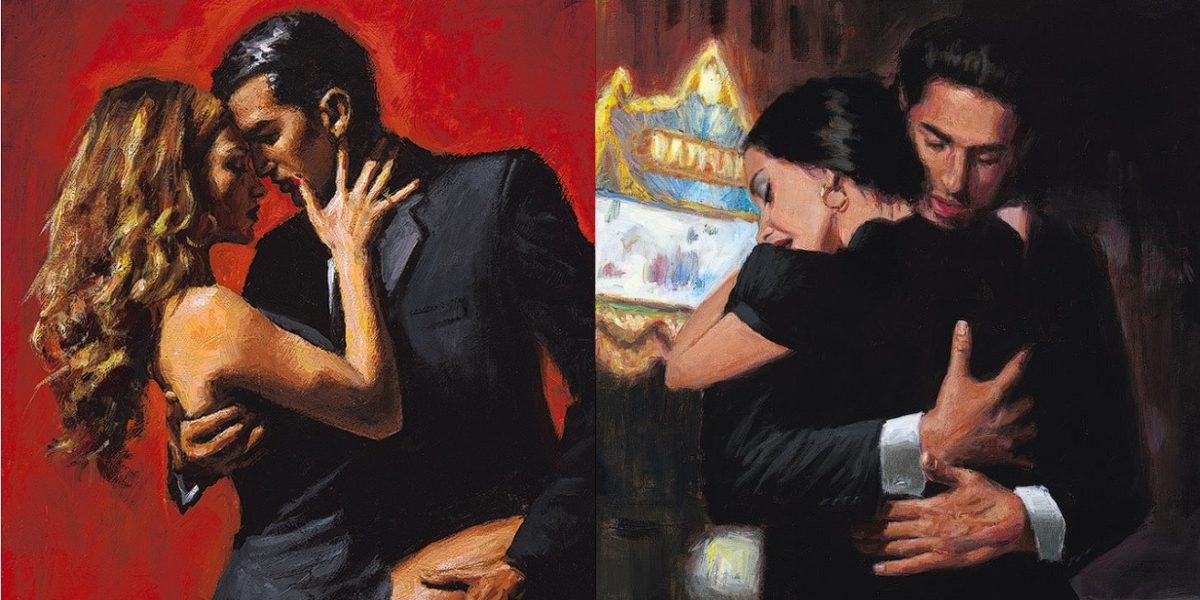By: Luna Dela Rosa
Neo-Emotionalism, the art movement created by Fabian Perez, is often described as pulsing with the immediacy of human experience. The artist and his style blend classical technique with a contemporary edge, capturing moments that are both deeply personal and universally felt. Perez’s distinctive style could be considered the heartbeat of Neo-Emotionalism—it embodies its soul.
His canvases are filled with an energy that evokes the nightclubs of Buenos Aires while speaking directly to contemporary collectors worldwide. Galleries across the globe have increasingly represented his work, suggesting an artistic vision that elevates ordinary figurative painting into something that many find compelling.
Perez operates within a rarified sphere where traditional technique meets modern sensibility. His paintings don’t simply decorate walls; they tend to command attention, drawing viewers into narratives that feel both timeless and urgently contemporary. The numbers seem to reflect this growing appreciation: galleries from New York to Tokyo appear eager to showcase his latest pieces, while collectors frequently design entire rooms around his distinctive aesthetic.
The Architecture of Artistic Success
What may separate Perez from other established contemporary artists lies not just in technique but in his understanding of emotional geography. His figures emerge from shadows and light with a cinematic quality that some critics say owes as much to film noir as it does to classical painting traditions. Each brushstroke carries a sense of weight, and each composition appears to tell a story that resonates across cultural boundaries.
The global art market, which reached an estimated $57.5 billion in 2024, has shown an increasing interest in figurative work that bridges traditional craftsmanship with contemporary themes. Perez occupies this sweet spot with remarkable consistency. His sculptures and art books seem to complement his paintings, helping to create what some industry insiders describe as a complete artistic ecosystem. Collectors often choose to invest in a worldview rather than just individual pieces.
The Master of Living Legends: Portrait Excellence
While Perez’s atmospheric scenes of tango dancers and intimate nightclub moments have garnered international attention, his portraiture work is often regarded as his most prestigious achievement. Widely recognized as one of the most accomplished portrait painters of the 21st century, Perez has elevated the traditional art of portraiture into something that can be seen as contemporary legend-making.
His Living Legends series features portraits of global figures: Pope Francis, whose portrait now resides in the Vatican’s private collection; Argentine President Mauricio Macri; football icon Lionel Messi; Hollywood legends Al Pacino and Arnold Schwarzenegger; tennis champion Rafael Nadal; and music industry figures like Quincy Jones and Ringo Starr.
What distinguishes Perez’s portraits from conventional celebrity artwork lies in his ability to capture what he calls the “soul” of his subjects. “Every person has a story. When you paint a person, it is not just a person, it is the whole space and mood around them, and inside them,” he explains. This philosophy can transform each commission into something more than just a likeness; they become psychological studies rendered with the same cinematic lighting and emotional depth that characterize his broader Neo-Emotionalist work.
When Pope Francis viewed his portrait, the Pontiff’s response appeared to affirm this approach: “When I see this painting, I see a reflection of myself.” This level of recognition from subjects themselves suggests Perez’s rare ability to reveal character through canvas, making each portrait not just a representation but a revelation. The commercial implications seem equally impressive. These high-profile commissions appear to create prestige that can elevate his entire body of work, introducing new collectors to Neo-Emotionalism through the cultural currency of celebrity portraiture.
Neo-Emotionalism’s Market Momentum
The movement Perez helps define represents more than just an aesthetic preference; it may indicate a broader shift in collector psychology. Contemporary buyers, particularly those under 50, seem to be gravitating toward work that combines technical excellence with emotional accessibility. They often reject the sometimes impenetrable conceptualism that dominated previous decades, seeking instead art that speaks immediately while rewarding deeper contemplation.
His artistic methodology is often seen as defying easy categorization. Where others might rely on photographic reference or digital manipulation, Perez works from direct observation and memory, gradually building layers of meaning through accumulated detail. The result feels both spontaneous and carefully considered, emotional yet intellectually rigorous.
The international scope of his representation network reflects art’s increasingly global nature. Collectors in Asia often respond to his work’s universal themes, while European buyers tend to appreciate its technical sophistication. American galleries report continued success across diverse demographics, suggesting his appeal transcends traditional collector categories.

His work captures fleeting moments with permanent media, freezing gestures and expressions that feel caught rather than posed. This quality distinguishes his work from much contemporary figurative painting, which can appear static or overly composed. Perez’s figures seem to breathe, to move within their frames, creating an almost cinematic viewing experience.
The business of being Fabian Perez extends beyond studio practice into sophisticated brand building. His website serves as both portfolio and philosophy, presenting work within carefully curated contexts that serve to enhance rather than overwhelm. This attention to presentation reflects an understanding that contemporary art consumption involves multiple touchpoints, from initial digital encounter to final gallery purchase.
The art world often admires nothing more than discovering the next big thing, but sometimes the next big thing is simply the result of years of quiet, consistent work that suddenly appears inevitable. Perez seems to represent this phenomenon well. His Neo-Emotional figurative style doesn’t scream for attention; it gains it through consistent excellence and genuine emotional resonance. His paintings continue doing what great art has always done: they invite people to stop, look, and feel something profound. That’s not just good art; that’s good business, and it’s why collectors worldwide have increasingly taken notice.

















